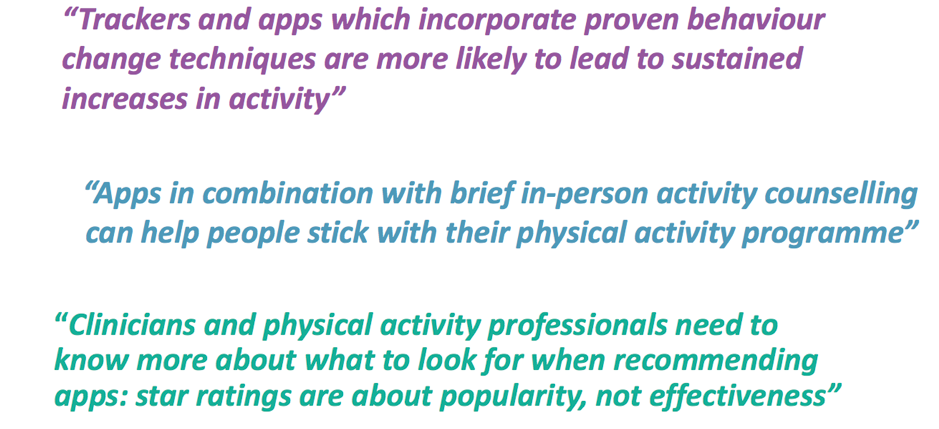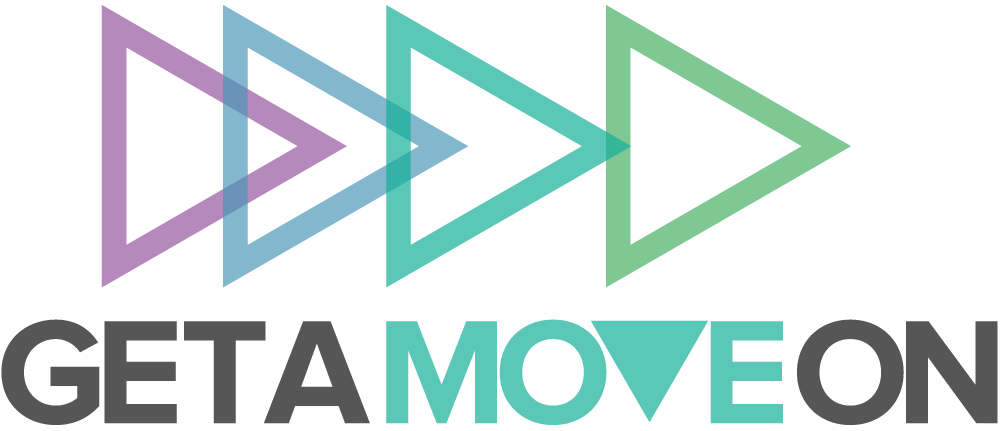Deep Dive #4
Should we just give everyone an activity tracker? Would that do the trick?

Surface skim
In August 2019 the Singapore government announced plans to provide their 5.6 million population with wearable fitness trackers in a nationwide public health initiative, but can it really be that simple to get people moving more? Activity trackers are very popular, but most don’t offer much support to help people maintain or increase their physical activity. As a result, people often use them for a while but then abandon them. Using them in conjunction with in-person support or appropriate app-based activity programmes can make them more effective, but the popularity of apps (e.g. star ratings) is not a good guide to how effective they are likely to be.67 Clinicians, service providers and people involved in delivering technology-enabled physical activity programmes need to understand how to select appropriate technologies for people and use them effectively. We also need to think beyond apps and wearables: there is huge potential for remote delivery of large scale, cost-effective physical activity programmes for whole communities of people with specific needs, via the web, mobile phones and even smart speakers.
Deep dive
In August 2019 the Singapore government announced plans to provide their 5.6 million population with wearable fitness trackers in a nationwide public health initiative, but can it really be that simple to get people moving more?
Combining technology with additional support for maximum impact
While activity trackers have risen in popularity and are effective at measuring activity levels, they offer little support to help maintain, improve or encourage physical activity and are often abandoned when used in isolation.37 However, when used in conjunction with mobile-based exercise programs, they can be successful in helping people to increase and maintain their activity levels.38
Similarly, using a physical activity education app alongside brief in-person counselling has been shown to increase activity levels, both short- and long-term, in physically inactive women.39
This was also the case in a recent review of research relating to the use of activity trackers by older adults. It found that synching activity trackers with apps and combining apps with professional support were both factors in the success of tech-based interventions to help older adults move more.36
The importance of incorporating behaviour change techniques
In order to make meaningful changes to people’s lifestyles, digital technologies need to incorporate behaviour change techniques19, which are effective in prompting and supporting people to make lasting changes over time, rather than focusing on short-term changes.41
However, behaviour change techniques must be chosen carefully. Some, such as reminders and streaks are effective at supporting repetition of new behaviours, but this creates change that depends on continued use of the app rather than change which is independent of it. This dependency makes lasting behaviour change less likely, as people often abandon the app, and when that happens, they go back to their old behaviours.42
Paulina Bondaronek, a PhD researcher at UCL and behaviour change advisor for Public Health England, has identified some of the key features that should be included in the design of technology for physical activity to promote behaviour change: information, encouragement and routine building.43
Information and feedback
People are able to monitor and get feedback on their physical activity through the use of technologies like wearables and smartphone-based activity tracking. This helps them to maintain an active lifestyle.44 They can also set and track goals. Reflecting on achievements and progress helps people’s motivation45 and enables them to build belief in their own ability, an important factor in maintaining physical activity.46 However, it may take some time for people to see noticeable effects, so providing educational materials can help them to understand the context of the feedback and the unseen impact of increased physical activity.39, 47
Encouragement
Including methods for extrinsic (external) encouragement can support people to continue being more physically active. This can come from motivational messaging to encourage people to go for their daily walk48, virtual or real-life rewards for reaching milestones 45, 49, 11 or through the use of social networking and community building to help people encourage one another.50, 8 A review of data from health insurer Vitality’s Active Rewards incentive programme which offers rewards for undertaking physical activity (verified in the main by tracker data) found short-term incentives both increased and prolonged members’ engagement in physical activity over and above the use of trackers and long-term incentives. The order of magnitude of the change was considerable enough to have a likely impact on health outcomes.51
Routine-building
Technologies that include features to support routine-building can help people to continue past perceived barriers and promote continued engagement.43, 52 While learning and seeing progress is important, this can only be achieved over time. Giving people encouragement is important in helping them to get to the point where they start to develop habits and to feel improvements in their capability.
Beyond apps and wearables
Apps and wearables are perhaps the most commonly used technologies to support physical activity on an individual level, but another important area is the use of digital technologies to enable cost-effective, large scale, delivery of physical activity programmes, information and advice to whole communities of people. Examples include remote delivery of personalised rehab exercise advice following knee replacement53; the use of smart speakers to provide families with advice and prompts to make healthy changes54 smart yoga mats to help people perform their physio exercises correctly and overcome backpain55; and internet-based exercise programmes tailored to the needs of cancer survivors in areas where there is no specialist provision or who are unable to travel.56
Case studies
Does popularity mean effectiveness?
GetAMoveOn Fellow, Paulina Bondaronek, has found that high star ratings for health apps in the iTunes and Google Play stores don’t necessarily mean that they incorporate behaviour change techniques known to be effective in increasing physical activity, so are not more likely to be effective67. There is a need to raise awareness amongst clinicians and exercise professionals about what to look for when recommending apps so that they are not reliant on star ratings.
Better health for people with cancer – wherever and whenever they are
Exercise can really help cancer survivors to overcome the challenges they face as a result of their cancer and the treatment itself. But what if you can’t actually make it to your local gym or the classes aren’t suitable? Dr Cindy Forbes, a GetAMoveOn Fellow and researcher from the University of Hull is harnessing the unique possibilities of digital technologies to create an online programme that will enable people to experience all the health benefits of a face-to-face group from a distance, ‘wherever and whenever they are’. Watch Dr Cindy Forbes' video here.
Transforming pain management with tech-enabled physio care
Physiotherapy can be very effective for managing back pain but ongoing face-to-face and hands-on care is prohibitively expensive. GetAMoveOn Fellow Anjana Wijekoon is developing a system using wearable devices and smart exercise mats to monitor how people are performing their exercises at home and give them personalised feedback to optimise the benefits so they recover better and faster. Watch Anjana Wijekoon's video here
Does tracking actually help us change our habits?
Watch the video: Is your activity tracker actually preventing you from getting the exercise habit?
What's wrong with fitness apps?
Watch the video: There are over 300,000 health apps so why aren’t we all fit?
You may also be interested in:
Deep Dive #1: What really motivates people to be more active?
Deep Dive #5: Aren’t we all addicted to our phones? Shouldn’t we be using technology less, not more?







